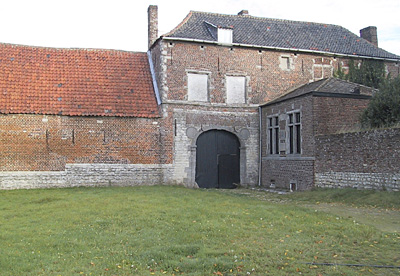 What follows is a brief rambling account of my recent trip to Brussels, Belgium to see the Belgian Army Museum and of course Waterloo. Hopefully it will be of some use to future Napoleonic nuts making their trip to Mecca.
What follows is a brief rambling account of my recent trip to Brussels, Belgium to see the Belgian Army Museum and of course Waterloo. Hopefully it will be of some use to future Napoleonic nuts making their trip to Mecca.
Hougomount
Being a die-hard Napoleonic wargamer the pilgrimage to the Waterloo Battlefield was one that I had waited years to take.
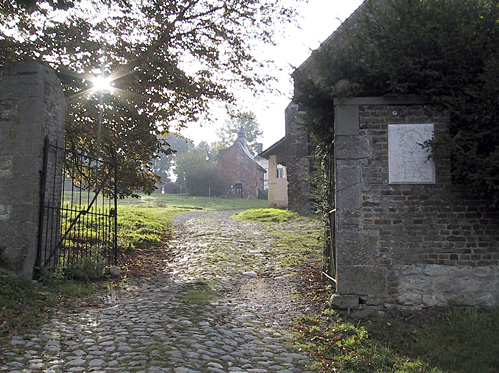
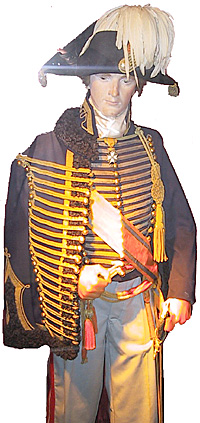 Waterloo
Waterloo
There are plenty of primers on what to see around Waterloo and I looked them up prior to going and it helped focus my trip. In order to see all of the battlefield and sites associated with it you need a minimum of a 2 day stay in the area.
Left: Prince of Orange.
Right: Peering into Hougomount.
The state of the battlefield is akin to how Gettysburg is in the US. It has been commercialized and life around the site has evolved with time.
Most noticeable is the Butte de Lion (Lion Mound) raised on the site where the Prince of Orange was wounded by a spent musket ball along the Allied line. At that location there is a visitor center, a small wax museum and the panorama building (large circular painting of the grand French cavalry attack on the Allied position).
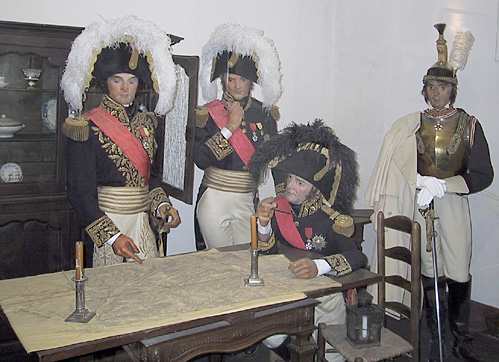 A scene from the wax museum.
A scene from the wax museum.
I have already mentioned that the site was commercialized a bit but that is really just around the Lion Mound. If you go to any of the farm houses (Hougomount, La Haye Saint…) they are all private dwellings and operational farms.
I did wander around the outside of each site and took some snaps with my digital camera but felt like I was going to intrude if I started to poke around their house. A lot of plaques and memorials dot the landscape – all in various stages of wear from the elements.
I visited Placenoit and saw the memorial to the Prussians (hidden on thicketed corner with a lot of weather damage). The town itself was open and as a wargamer it made me realize that I needed to try and capture the ‘built on a sloping ground’ feel that the town center had. Most games I have put on with my 28mm Napoleonic collection have had the towns and such devoid of rolling terrain. Now this of course ‘ups the ante’ when it comes to terrain construction but I have a few ideas that I will explore.
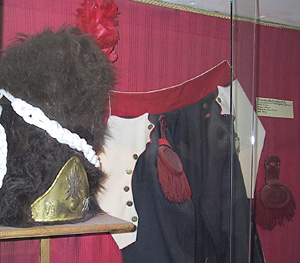 Old Guard Uniform
Old Guard Uniform
My wife, 2 year old daughter and I did enjoy lunch at the restaurant right behind the visitor center. The cuisine was excellent and there were all kinds of Napoleon knick-knacks around the place (flags, busts, paintings). The restaurant was called Napoleon’s Tavern or something like that. Wellington had his restaurant across the street but it appeared to be closed for the season.
I eventually visited the Wellington museum farther north of the Waterloo visitor site. The building I believe was Wellington’s HQ during the battle (Mt. St Jean). It is a nicely run place and should not be missed – especially if you care to see Napoleonic British uniforms and such. My wife shopped around for a while in the local stores as I ran up and down the museum like a goofy tourist with my camera photographing everything in site.
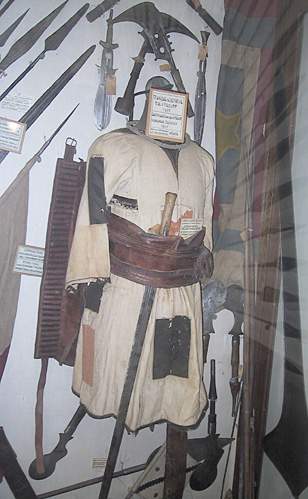 Belgium Army Museum (Brussels)
Belgium Army Museum (Brussels)
This museum sits in a park on the SE side of Brussels. There are 2 other museum located right next to it (one was for cars) but I didn’t see anything in those due to time.
Mahdist tunic at the Belgian Army Museum
The museum was pretty large and had artifacts from the Middle Ages up to WW2. The Napoleonic period was fairly thin as that was the time that modern Belgium first started to emerge as a Nation State. There were 2 things that struck me in the pre-WWI section of the museum: Bearskins and cuirass were both in vogue in Europe. I kept double taking looking at different items that had a very ‘French style’ about them.
Another interesting piece of trivia was the section of Mahdist artifacts from the Sudan. This included their tunics and over decorated firearms. There was of course a section on the Belgian contingent in Africa which had plenty of interesting items in it as well. By the time I reached the WWI area the stamina of my wife and daughter started to flag and I just made a whirlwind trip through the rest of the museum. For some reason there were a lot of Russian pieces in the WWI section (to include the mitre grenadier caps left over from the Napoleonic period).
Overall impression of the museum was a good one. It made me realize just how dedicated man has been to killing his neighbors. If you stop and think about it the civilized world has expended an enormous amount of energy over time in the development of weaponry. I am not damming society for it just noting the fact.
Conclusion
I went off season and overall had an excellent time of it. What will strike a US traveler in Europe right off is the sticker shock for fuel. Now we in the US have had it good for a long time regarding gas prices so it is part of the cost of living if you want to travel around Europe using your own vehicle or a rental. My car (van) took 60 litres (a full tank of gas) for ~75.00 Euro or about 100.00 USD.
Another important note for those driving / navigating around Brussels – the street signs are mostly on the sides of buildings. They are about the size of a US license plate and are unlit at night. If you are not careful you will be very confused and lost after dark. This happened to my wife and I as we tried to locate our bed and breakfast the first evening.
Back to War Lore: The List
Back to Master Magazine List
© Copyright 2004 by Michael Panko.
This article appears in MagWeb (Magazine Web) on the Internet World Wide Web.
Other articles from military history and related magazines are available at http://www.magweb.com